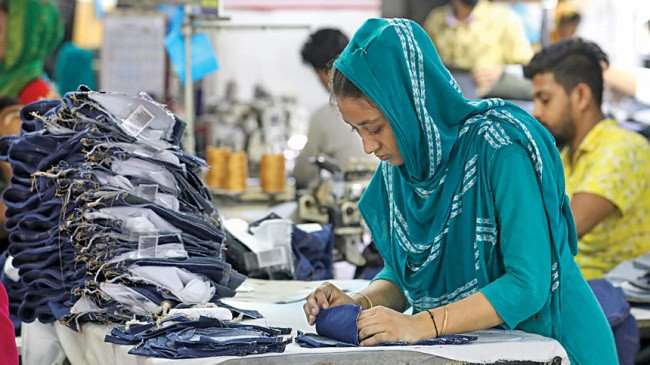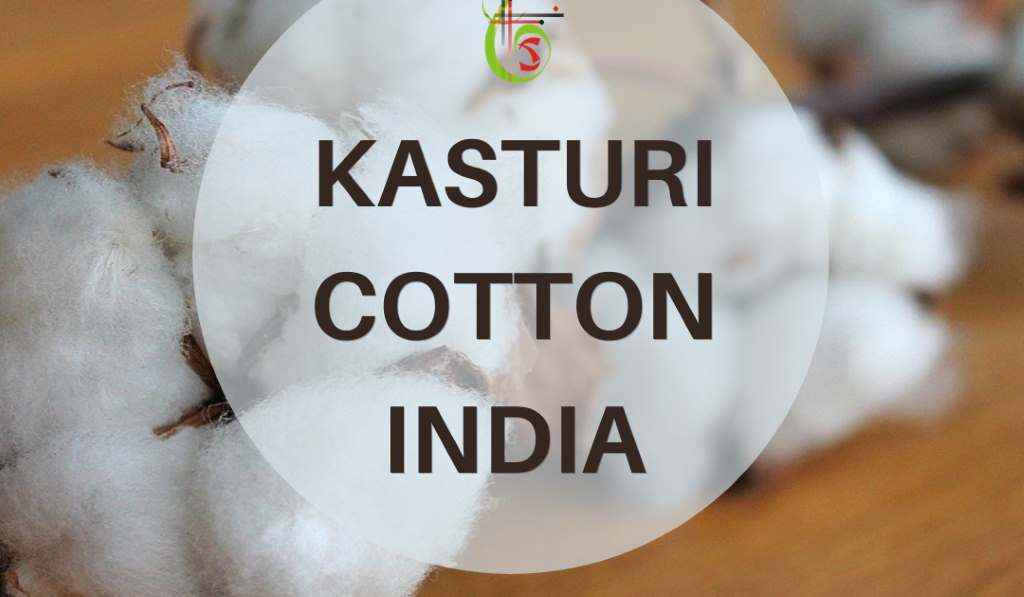FW
During his recent visit to the Central Institute for Cotton Research (CICR). Union Textile Minister Giriraj Singh announced an ambitious plan to expand the High Density Plantation System (HDPS) to boost cotton cultivation in Akola.
According to Singh, covering 50,000 hectare, the initiative aims to enhance farmers' incomes and boost cotton yields, potentially increasing production to 1,500 kg per acre starting next year.
Currently implemented on 3,500 hectare in Akola, HDPS has shown impressive outcomes. The government aims to expand the successful Akola model across the country’s three cotton-growing zones—North, South, and Central, The plan includes using BG-II cotton variety seeds to plant on the new 50,000 hectares in June 2025.
The HDPS approach was first adopted by Akola farmer Dilip Thakre in 2023 on just 2 hectare. Since then, more than 1,500 farmers have embraced this close-spacing method, which allows for cultivating more plants in less space. Farmers following best practices have been able to produce between 14 to 18 quintals of cotton per acre, shares Thakre. The government has increased its subsidy for HDPS from Rs 16,000 to Rs 21,000 per hectare, with farmers now expanding their sowing efforts under this innovative system, he adds.
The Ministry of Agriculture and the Ministry of Textiles in India are collaborating to ensure cultivation of high-quality cotton crops the country, noting the global cotton market is valued at $350 billion, which includes various fibers like wool, silk, and man-made materials. He revealed, India aims to produce 20 million tons of cotton annually.
While global competitors such as China, Australia, the United States, and Russia achieve yields of 2,000 to 2,200 kg of lint per hectare, India currently averages around 450 kg. However, Singh hopes, HDPS will elevate India’s yield to 1,500 and 1,800 kg of lint per hectare by engaging farmers, officials, scientists, and Krishi Vigyan Kendras in the Vidarbha districts.
With 3,500 hectare already utilising HDPS in Akola and an additional 8,000 hectare across eight states, India aims to set new standards in cotton production practices nationwide.
During its annual meeting in Coimbatore on Sep 25, 2024, the South India Spinners Association (SISPA) urged the Cotton Corporation of India (CCI) to establish cotton warehouses in Tamil Nadu, as textile mills in the state consume 45 per cent of the country’s cotton production.
Emphasising on the need for these warehouses to facilitate easier access to cotton, SISPA proposed that mills that purchase cotton from the CCI after the free period should be charged a reduced interest rate of 6.5 per cent, rather than the current 15 per cent. They also urged the Central Government to implement direct transfers of the Minimum Support Price (MSP) to cotton farmers selling to the CCI, while monitoring whether cotton mills are purchasing beyond their consumption capacity to prevent excess stockpiling.
Additionally, SISPA requested an exemption from the 11 per cent duty on cotton imports from April to October to ensure a steady supply of raw materials for the textile industry, without compromising farmers' livelihoods.
The Association recently also honored three of its former presidents—V. Soundararajan, Ellen Textiles; K. Narayanasamy, Micro Cotspinn India, and AV Ramaraj,AVR Textiles—with the Scroll of Honor Lifetime Achievement Award.
As global fashion faces new green supply-chain regulations, clothing manufacturers in Bangladesh are looking to major international brands for support. The European Union’s Corporate Sustainability Due Diligence Directive (CSDDD), enacted in July, mandates corporations to ensure sustainable practices in their global value chains, particularly in worker rights and emissions.
Abdullah Hil Rakib, managing director at Bangladesh's Team Group, emphasized the need for collaboration with global buyers to achieve green transition goals amidst Bangladesh's political shifts following recent protests over job crises. The CSDDD aligns corporate practices with the Paris Agreement, requiring brands to ensure their suppliers protect labor rights and the environment.
The directive presents an opportunity for suppliers to negotiate better contracts, though challenges remain. Rakib estimates that suppliers will need to invest an additional 20 per cent to 30 per cent to meet sustainability standards. The transition requires legal reforms in manufacturing countries, complicating compliance for brands and suppliers.
Despite their differing capacities to adapt, industry experts highlight the need for a shared responsibility between brands and suppliers to meet the CSDDD’s requirements. The Apparel Impact Institute estimates the fashion industry must invest over $1 trillion to transition to net-zero emissions by 2050. Union leaders stress the importance of establishing clear channels for addressing labor rights violations as these regulations are implemented, urging support for workers facing climate-related challenges in garment-producing countries like Bangladesh.
Karl Mayer Group will showcase its latest technologies at ITMA ASIA + CITME, from October 14 to 18, 2024, in Shanghai. Concurrently, an in-house event at Karl Mayer (China) in Changzhou will highlight warp knitting and flat knitting machines, beginning October 13. The opening day will feature the inauguration of the company’s new showroom, displaying solutions from all technology segments.
Visitors will witness the performance of seven warp knitting machines, including models from the HKS and TM series, such as the HKS 3-M ON Plus and the new Textronic Lace MT 84/1/40 S. A new mid-range DM 6/2-6 EN double Raschel machine will be launched, focusing on excellent price-performance.
An exclusive textile show will inspire new business opportunities, featuring products like sun protection textiles, casual wear, and shoe fabrics. For flat knitting, the Stoll lineup will be on display, including the versatile CMS 703 ki knit and wear, capable of producing fully-fashioned articles.
Karl Mayer’s digital solutions, such as Digital Production Management and the Quality Monitoring System, will be presented, offering advancements in production and quality management. The Stoll PPS system and Create software solutions aim to enhance efficiency and speed up the design-to-market process.
The new showroom in Changzhou, spanning 480 square meter, will exhibit textile innovations, trend themes, and technological advancements across all Karl Mayer business units.
The integration of Style3D, Assyst with KM.ON’s Create Design software offers apparel companies a streamlined solution for 3D fashion and knitwear design. This new tool allows designers and product developers to create and visualize complex knitwear patterns, including techniques like Cable, Aran, Pointelle, Jacquard, and Intarsia, directly in KM.ON. Digital yarns can be used, and the designs are transferred seamlessly to Style3D Studio using a custom plugin.
In Style3D Studio, these knitwear designs can be simulated in 3D on avatars, incorporating features like styling, animations, and style sharing via QR code or link. The AI rendering module also enables digital photoshoots, making it ideal for eCommerce and showroom promotion.
This integration helps fashion companies reduce time-to-market and cut costs, as they can now visualize and produce knitwear collections more efficiently. The solution is available with Style3D Studio 7.0 and 7.1, as well as all levels of the Create Design software.

In just over a decade, Shein has transformed the fast fashion landscape, becoming a global phenomenon known for its ultra-cheap clothing, vast online selection, and trend-driven styles. The company's business model hinges on a lightning-fast supply chain that leverages AI technology to predict consumer demand and rapidly produce new designs.
This ‘ultra-fast fashion’ approach has given a boost to Shein’s revenue that reportedly exceeded $30 billion in 2023. The company has an estimated 600,000 items available for purchase at any time, with an average price of $10. Its appeal to Gen Z consumers is undeniable, with 44 per ent of American Gen Zs making at least one Shein purchase per month.
The environmental cost of speed
Indeed, Shein's extraordinary success comes at a steep environmental cost. The sheer volume of clothing it produces, combined with its reliance on fossil fuel-based materials and rapid shipping practices, contributes significantly to greenhouse gas emissions and pollution. Critics argue Shein's business model, while efficient and profitable, is inherently unsustainable.
The release of Shein's third annual sustainability report recently has intensified concerns about the company's environmental impact. The report revealed a near doubling of Shein's carbon dioxide emissions between 2022 and 2023, highlighting the challenges the company faces in balancing its growth with sustainability commitments.
Highlights on some concerns
Carbon footprint: The production and transport of Shein's vast inventory generates a significant carbon footprint. Estimates suggest Shein's annual carbon emissions could range from 6.3 million to 12.6 million metric tons of CO2 equivalent, rivaling the emissions of entire countries. The company's heavy reliance on synthetic fibers, primarily derived from fossil fuels, further contributes to its emissions.
Water usage: The textile industry is a major consumer of water, and Shein's high production volumes inevitably translate to substantial water usage. It is estimated that Shein's operations could consume upwards of 70 billion liters of water annually, enough to fill nearly 28,000 Olympic-sized swimming pools.
Waste generation: The short lifespan of fast fashion garments contributes to a global waste problem. Many Shein items end up in landfills after just a few wears. Shein's waste generation is estimated to be in the hundreds of thousands of tons per year, adding to the mounting problem of textile waste.
AI's role: The use of AI to accelerate production and shipping processes could be exacerbating Shein's environmental impact by encouraging even higher consumption and turnover rates.
Despite facing criticism, Shein has publicly committed to reducing its environmental footprint. The company has set ambitious goals, including a 25 per cent reduction in carbon dioxide emissions by 2030 and achieving net-zero emissions by 2050. Shein highlights several initiatives in its sustainability report.
Shein says it aims to transition its operations to renewable energy sources. The company is working with suppliers to implement energy-efficient practices. And Shein is researching ways to incorporate recycled materials into its products and encourage garment recycling.
Indeed, while Shein's sustainability commitments are laudable, the company faces significant hurdles in achieving these goals. Its business model remains fundamentally reliant on high consumption and rapid turnover, presenting inherent challenges to sustainability. The near doubling of its carbon emissions in a single year underscores the scale of the task ahead. Critics are skeptical about Shein's ability to reconcile its business model with meaningful environmental progress.
In fact, Shein’s ambitious sustainability pledges face touch challenges against its rapid growth and insatiable consumer demand. The fashion industry's future hinges on finding a balance between affordability, style, and environmental responsibility, and Shein's path forward will undoubtedly be closely watched.

The relentless rise of cheap fast fashion and ultra-fast fashion brands has impacted the global fashion industry in more ways than one. The consequences of this trend are far-reaching, affecting both consumer behavior and also the once-thriving secondhand clothing trade. The allure of trendy, disposable clothes at rock-bottom prices has led to a decline in demand for pre-loved garments, posing a significant challenge to the circular economy and sustainability efforts.
The shrinking secondhand market
As per industry estimates the secondhand clothing market has reduced by as much as 30 per cent in recent years, directly attributed to the proliferation of cheap fast fashion. The ease with which consumers can purchase new garments at a fraction of the cost of secondhand items has reduced the appeal of pre-loved clothing, leading to a surplus of unsold inventory and a decline in the value of secondhand goods.
The impact of this shift is felt most acutely in developing countries, which have traditionally relied on the secondhand clothing trade as a source of affordable clothing and economic opportunity. The influx of cheap fast fashion has disrupted local markets, displacing small businesses and contributing to unemployment. The following table illustrates the impact on key regions:
Table: Impact on key regions
|
Region |
Estimated decline in secondhand trade |
Key impacts |
|
Sub-Saharan Africa |
40% |
Loss of livelihoods, increased textile waste, dependence on imported clothing |
|
South Asia |
30% |
Decline in local textile industries, environmental concerns |
|
Latin America |
25% |
Reduced economic opportunities, increased consumerism |
Role of government policy
Government policies play a crucial role in mitigating the negative impacts of cheap fast fashion and supporting the secondhand clothing trade. Several policy interventions can be considered:
Extended Producer Responsibility (EPR): Holding fast fashion brands accountable for the end-of-life disposal of their products can incentivize them to adopt more sustainable practices and reduce waste.
Taxation and incentives: Imposing higher taxes on fast fashion brands and offering incentives to secondhand businesses can help level the playing field and promote a more circular economy.
Consumer awareness: Educating consumers about the environmental and social costs of fast fashion can encourage more mindful consumption habits and support for secondhand clothing.
The continued dominance of cheap fast fashion has several long-term side effects. The production and disposal of fast fashion garments contribute significantly to pollution, resource depletion, and greenhouse gas emissions.
Moreover, the decline of secondhand trade increases economic disparities between developed and developing countries. What’s more the homogenization of fashion trends erodes cultural diversity and traditional textile practices.
The rise of cheap fast fashion has had a profound impact on the secondhand clothing trade, with far-reaching consequences for the environment, economy, and society. Addressing this issue requires a multi-faceted approach involving government policy, industry action, and consumer awareness. By promoting sustainable consumption habits and supporting the circular economy, we can mitigate the negative impacts of fast fashion and build a more equitable and resilient fashion industry.

Shifting consumer trends, supply chain disruptions, and a growing desire for sustainability and localized production has had its effects on US sportswear segment. As legacy brands like Nike and Adidas grapple with declining sales and a rapidly changing landscape, a new project in Portland, Oregon, aims to revitalize the US sportswear manufacturing scene and rewrite the industry's playbook.
The ambitious $125 million ‘Made in Old Town’ project in Portland seeks to revitalize domestic production, drawing lessons from past successes and failures. Spearheaded by startup Hilos and backed by industry veterans Nike and Adidas among others, the initiative aims to establish a stateside manufacturing hub, potentially creating 6,000 jobs by 2028. The initiative aims at bringing footwear and apparel production back to the US, offering brands faster turnaround times, greater control over quality, and the ability to respond swiftly to market demands.
The shifting landscape
Historically, the sportswear industry in the US has relied heavily on overseas manufacturing, particularly in Asia. This model, while cost-effective, has faced challenges in recent years, including supply chain disruptions, rising labor costs, and concerns about sustainability. The pandemic further exposed the vulnerabilities of this model, prompting a reevaluation of manufacturing strategies. As Elias Stahl, CEO of Portland-based Hilos, told Business Insider "Factory owners and suppliers need to be globally competitive in manufacturing and need to be able to be closer to brands."\
Lessons from Adidas' Speedfactory’ flop
The Made in Old Town project is not the first attempt to bring sportswear manufacturing back to US soil. Adidas' Speedfactory initiative, launched with much fanfare a few years ago, aimed to revolutionize shoe production with automated factories in Atlanta and Germany. However, the project ultimately failed due to its inability to keep up with fast-changing fashion trends and the lack of support from materials suppliers.
Eric Liedtke, former Adidas executive and current ‘Made in Old Town’ board member, emphasizes the importance of learning from past mistakes. He says, they gave Speedfactory their best effort. It just didn't work out. The model was partly flawed because the technology could not account for quickly changing fashion trends. Only one shape of footwear could be created at a time, limiting production efforts.
Made in Old Town aims to address these challenges by focusing on flexibility, adaptability, and fostering collaboration between brands, manufacturers, and suppliers. By creating an ecosystem where all players can work together seamlessly, the project aims to unlock innovation and accelerate the pace of production.
Positive side of localized production
Made in Old Town aims to address the challenges of sourcing from abroad by creating a collaborative ecosystem that fosters innovation and agility. The project envisions a campus where designers, manufacturers, and materials suppliers can work in close proximity, streamlining the product development process. The integration of 3D printing and other advanced technologies is expected to further accelerate production and enable brands to respond swiftly to market trends.
While the Made in Old Town project is still in its early stages, there are already examples of successful localized manufacturing initiatives in the sportswear industry. New Balance, for instance, continues to produce over four million pairs of shoes annually in the US, demonstrating that domestic production can be both viable and profitable. As Stahl explains, factory owners and suppliers need to be globally competitive in manufacturing and need to be able to be closer to brands.
Smaller brands are also embracing localized production to gain a competitive edge. For example, Unless, a plant-based footwear and apparel company, is leveraging 3D printing and sustainable materials to create products on demand, reducing waste and minimizing environmental impact.
It maybe noted that currently, nearly all shoes sold in the US are made abroad. The shift to overseas manufacturing led to a significant decline in domestic footwear jobs, from an estimated 76,000 in 1990 to just over 11,000 today. Legacy sportswear brands have faced challenges in recent years, with Nike, Adidas, and Under Armour reporting soft sales and announcing layoffs. While the US government has offered billions in subsidies to support manufacturing in other sectors, the apparel industry has largely been overlooked.
However, the US government has now shown support for domestic manufacturing, offering billions in subsidies to key industries. At the same time, the apparel sector has largely been overlooked, highlighting the need for private investment and initiatives like Made in Old Town.
Indeed, the Made in Old Town project is still in its early stages, but it represents a significant step towards reshaping the sportswear manufacturing landscape. By learning from past mistakes and embracing innovation, Portland aims to create a model that benefits both brands and consumers. The success of this initiative could inspire similar efforts across the country, potentially leading to a resurgence of domestic manufacturing.
H&M Hennes & Mauritz AB reported net sales of SEK 59,011 million for the third quarter of 2024, compared to SEK 60,897 million in the same period last year, with flat sales in local currencies. Gross profit for the quarter stood at SEK 30,133 million, translating to a gross margin of 51.1 percent, up from 50.9 percent last year. However, operating profit dropped to SEK 3,507 million, down from SEK 4,739 million, impacted by currency effects and winding-down costs.
For the nine-month period ending August 31, 2024, H&M’s net sales were SEK 172,285 million, marginally lower than the SEK 173,385 million recorded in the previous year. Gross profit improved to SEK 91,357 million, resulting in a higher gross margin of 53 percent compared to 50.3 percent last year. Operating profit rose to SEK 12,682 million, with a 7.4 percent margin, driven by better cost management.
Despite a challenging start, the company expects an 11 percent sales increase in September, fueled by a well-received autumn collection and investments in physical and digital store upgrades. Notable initiatives include the opening of the first H&M Beauty flagship store in Sweden, and upcoming launches on Chinese e-commerce platforms Douyin and Pinduoduo.
CEO Daniel Erver highlighted the strategic focus on strengthening the H&M brand through enhanced product offerings and marketing efforts, while addressing external challenges like high consumer costs and global instability. The board has authorized a share buyback program worth SEK 1 billion, set to commence on September 26.
H&M is set to open its first store in Brazil in Sao Paulo by late 2025, aiming for long-term growth and improved profitability.
Ukrainian denim brand Kseniaschnaider, founded by Ksenia and Anton Schnaider, has been honored with PETA Germany’s 2024 Vegan Award. The brand’s Chewbacca jeans, featuring their signature ‘denim fur,’ won in the category of Best Vegan Pants. This unique material is made from reworked vintage denim and frayed offcuts, offering a sustainable and animal-friendly alternative to traditional fur.
PETA Germany praised Kseniaschnaider for its dedication to sustainability and its refusal to discard even the smallest fabric scraps. Harald Ullmann, co-founder of PETA Germany, applauded the brand’s commitment to ethical fashion, stating that the collection exemplifies how vegan fashion can benefit animals, people, and the planet.
The PETA Vegan Award, now in its 11th year, celebrates brands like Kseniaschnaider that create innovative, animal-free fashion. Other 2024 winners include GmbH, Armedangels, and Amina Muaddi for their eco-conscious designs.












